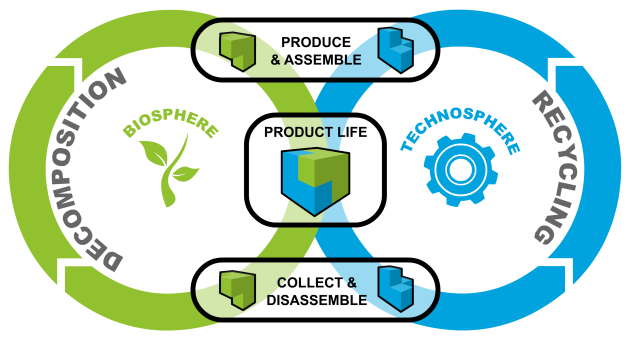Cradle to Cradle: Hype or hope?
 I’ve been meaning to make a post about Cradle to Cradle (C2C) for a while and last week we had a mini-symposium about it at the TU Delft with the attendance of Michael Braungart, one of the original C2C advocates, so I figured that this was the perfect excuse to get down to it.
I’ve been meaning to make a post about Cradle to Cradle (C2C) for a while and last week we had a mini-symposium about it at the TU Delft with the attendance of Michael Braungart, one of the original C2C advocates, so I figured that this was the perfect excuse to get down to it.
So, to get started, let’s explain the C2C concept a little bit, and the best way to explain Cradle to Cradle is to first explain what Cradle to Grave means.
Until not so long ago, our production paradigm was focused on manufacturing products as cheaply as possible which would be later discarded into landfills (in the worst case) or burned up for energy (in the best case), meaning that we were producing or processing materials (cradle) which would later be rendered useless because they were being buried or destroyed (grave). We later picked up on the fact that this can have a great impact on the environment in terms of pollution and be quite expensive in terms of production as new materials have to be manufactured from scratch every time, so we came up with the idea of recycling (at least the most obvious of the materials we had at hand, like paper, plastic and scrap metal). Yet we have still not reached a point in which we can recuperate all of the materials and energy we put into the production of our goods and we are thus creating more and more damage to the environment by continuing this trend.
This is where Cradle to Cradle comes in. C2C is a design certification inspired in the natural processes taking place in bio-systems in which the discarded material from one entity becomes the nutrients for other entities within the system. Think of how in a natural ecosystem animal feces become food for other species or decomposes to become nutrients for the soil, which in turn are used by the plants, as the cycle continues (waste = food).
The idea behind C2C is thus, to create a fully closed cycle in which through the use of appropriate design, manufacturing techniques and materials we can achieve products which can be fully re-gained both for the biosphere (all the naturally produced materials) as well as for the technosphere (all the other materials such as plastic which are not found in nature). C2C goes even a step further, advocating that other things such as appropriate policies, business models, working conditions and energy production (among others) should also be compliant with the C2C philosophy, since the idea is to create a society that has absolutely no ecological footprint whatsoever, or better said, in which our ecological footprint does not damage but actually enhances our environment.
In a nutshell: everything that we produce should be either brought back to nature in a natural decomposition process, or it should be brought back to the technosphere in a recycling process which does not damage the quality of the materials.

The parts of the Celle chair can be easily split to bring them back to the biosphere and the technosphere
So OK, let’s give a more concrete example of a C2C product: the Celle chair from Herman Miller. This office chair is often used as an example of a C2C product in which the construction follows a design for dis-assembly principle where all parts can be easily separated into the different materials which were chosen due to their recyclability qualities or in the case of those returning to the biosphere due to their ability to decompose in a natural process.
This sounds like a bullet proof philosophy, right? well, yes it is… the problems for C2C lie more on its practicality and on the certification than on the philosophy itself… or at least that’s what the experts say (I’d love to include myself in that select club of people who can call themselves experts, but unfortunately I can’t so I just give my humble opinion from what I know).
I personally think that the real key to properly implementing C2C in a grander scale lies in the lack (or very basic) management of the technosphere which we currently have in motion. Products made in one corner of the world are shipped half across the globe to countries in different continents, where very different socio/political/cultural variables play a role preventing us from properly managing how these material resources will be used and disposed of, and whether they will make it back into the cycle or not.
On another front and quoting Wikipedia on this, some experts believe that C2C is not giving any answers on how to achieve the goals it claims are possible. Materials experts argue that recyclability with the minimal quality losses described by C2C certification are more complex than what C2C cares to admit, etc.
My take on it is that in any case our current consumption and production paradigm is flawed and is en route to collapsing because we have a limited amount of resources combined with an increasing population and with an increasing consumption pattern, so one time or another we’re gonna need to completely rethink of all the things we are doing wrong because, for example a reduction of emissions and the use of eco-friendly materials alone is not going to take us anywhere if the system itself is not sustainable.
I think it was Michael Braungart (please if any one knows correct me if I’m wrong) who gave a great metaphor which I will paraphrase as follows:
“If we are in the US and we find ourselves driving towards Canada, no matter how much we slow down, we are not going to reach Mexico and we’ll undoubtedly end up in Canada”
I for one think that C2C is a great philosophy to follow as a designer (I don’t know if the certification will do you any good though) since it asks the right question and is a step in the right direction even if it’s not proposing all of the practical solutions yet. But hey, what are we here for then? If more people start getting involved and with the proper work and research, the answers will reveal themselves in due time.
To wrap it up and for those who would like a bit more in depth information, I recommend you take a read of the following document compiled by my friend Bram van der Grinten who is by now quite versed in the subject of Cradle to Cradle. The document gives a brief summary of the C2C book, the philosophy behind it and some design tools which can be useful in achieving your C2C goals.





